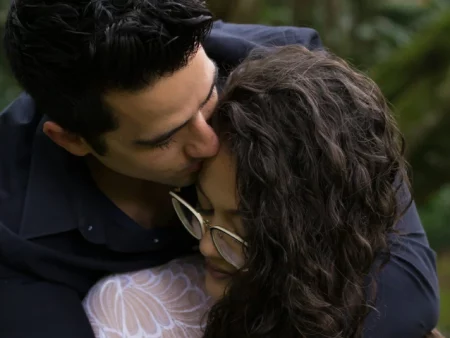Navigating the intricate landscape of human attraction demands careful consideration, especially when it involves a woman in a committed relationship. Subtle signals of interest require astute observation and ethical reflection. This article explores nuanced behaviors and gestures that might indicate attraction, emphasizing respect for boundaries and personal integrity. As we delve into these signals, it’s crucial to approach the topic with sensitivity, acknowledging the complexity of human emotions.
Understanding body language, eye contact, and changes in conversation patterns can provide insights into potential interest. However, it’s essential to remember that misinterpretation can lead to significant consequences. This exploration aims to foster awareness while promoting responsible and ethical behavior in complex interpersonal dynamics.
Understanding the Ethical Landscape
Navigating complex emotions demands careful consideration, especially when encountering potential interest from a married woman. The ethical landscape requires unwavering integrity and respect for existing commitments. When we observe signs that might indicate a married individual’s interest, approaching the situation with caution and empathy is crucial. The potential for harm extends beyond immediate parties, affecting families and wider social circles.
Maintaining personal integrity serves as a moral compass in these potentially turbulent waters. It’s essential to:
- Consider long-term consequences of actions and responses
- Prioritize open communication and honesty in all interactions
- Reflect on personal values and ethical decision-making
- Seek guidance from trusted sources when facing dilemmas
- Watch for nuanced cues without jumping to conclusions
Recognizing that misinterpreting friendly behavior as romantic interest can lead to uncomfortable situations is crucial. Cultivating emotional intelligence allows us to listen and observe without assumptions. By maintaining professional boundaries and fostering a respectful environment, we create space for healthy interactions that honor all parties’ commitments.
Navigating these scenarios requires a commitment to ethical principles that prioritize respect, honesty, and well-being. By approaching such situations with mindfulness, we can foster a culture of trust and mutual respect in our personal and professional lives, ensuring that we respond appropriately to any perceived signals of interest.
Non-Verbal Cues and Body Language

In the intricate dance of human interaction, non-verbal cues often speak volumes. When a woman feels a connection beyond friendship, her body language might reveal unspoken desires. Subtle shifts in posture, gaze, and proximity can create an invisible thread of chemistry between two people.
A lingering glance that extends beyond social norms can ignite a spark of curiosity. This visual connection might be accompanied by a warm smile or a coy blush, hinting at deeper emotions. An interested individual may find reasons to lean in during conversation, reducing the space between them. This closeness creates an intimate bubble, fostering a sense of exclusivity and shared energy.
Mirroring behavior is another subtle yet powerful indicator. Unconsciously mimicking postures, gestures, or speech patterns suggests a desire to engage and establish rapport. This synchronized dance of movements can create a comfortable atmosphere, encouraging further interaction.
Increased tactile behavior, such as light touches on the arm or shoulder, may signal a desire for closer connection. These fleeting moments of contact can send electric pulses of chemistry, leaving both parties curious about the potential for more.
Observing these non-verbal cues requires attentiveness and discretion. It’s crucial to notice patterns rather than isolated incidents, as misinterpretation can lead to uncomfortable situations. Remember, these signs don’t necessarily indicate a desire to leave a current relationship; they may simply reflect momentary attraction or emotional connection.
Ultimately, the language of the body is complex and nuanced. Learning to read these subtle signals with empathy and respect can deepen our understanding of human interactions, allowing us to navigate relationships with greater insight and sensitivity.
Changes in Communication Patterns
As relationships evolve, subtle shifts in communication patterns can reveal underlying emotions. When a woman develops feelings for someone outside her marriage, her interactions may undergo noticeable changes. The frequency of exchanges might increase, with conversations extending beyond casual pleasantries into more meaningful territory. She may respond more promptly to messages or initiate contact more often, seeking reasons to maintain dialogue.
The depth of discussions can also deepen, venturing into personal realms previously unexplored. A woman might share vulnerabilities or express curiosity about your life, indicating a desire for emotional intimacy. Her tone may become more playful or flirtatious, peppered with inside jokes or subtle innuendos. She might laugh more readily at your quips or find excuses to compliment you.
Non-verbal cues play a crucial role too. During face-to-face interactions, she may stare intently, maintaining prolonged eye contact. Her body language might become more open and inviting, subconsciously signaling attraction. If typically reserved, she may appear uncharacteristically nervous or shy in your presence.
Dr. Elena Hartwell, relationship psychologist, notes: “Changes in communication often precede conscious awareness of romantic interest. Pay attention to shifts in frequency, depth, and emotional investment in interactions, as these can be telling indicators of evolving feelings. However, it’s crucial to consider the context and not jump to conclusions based on isolated incidents.”
It’s important to react thoughtfully to these changes, considering the implications for all parties involved. If you sense that a married woman is sending obvious vibes of interest, approach the situation with empathy and respect for her existing commitment to her husband. Remember, misinterpreting friendly behavior as romantic interest can lead to uncomfortable situations and potentially fall into ethical gray areas.
Emotional Intimacy and Vulnerability
Emotional intimacy forms the cornerstone of deep human connections, transcending physical boundaries. When a woman seeks this profound bond outside her marriage, subtle yet significant shifts occur in her interactions. These nuanced changes can reveal a yearning for understanding and support beyond what her current relationship provides.
Key indicators of growing emotional intimacy include:
- Sharing vulnerable aspects of her life, revealing fears and insecurities
- Seeking your perspective on personal dilemmas, valuing your input
- Expressing desire for deeper conversations, beyond superficial topics
- Confiding dreams and aspirations she may not share with others
- Demonstrating increased empathy towards your experiences and emotions
- Revealing intimate details about her past or childhood
- Discussing her hopes for the future with enthusiasm
- Showing genuine curiosity about your thoughts and feelings
As this closeness develops, you might notice her becoming more flirtatious in her communication, using humor or playful banter to strengthen your connection. She may find reasons to initiate physical contact, such as a gentle touch on the arm during conversation, bridging the gap between emotional and physical intimacy.
It’s crucial to recognize that this vulnerability doesn’t necessarily indicate a desire for an affair. Often, it reflects a need for emotional fulfillment or understanding. Responding with empathy while maintaining appropriate boundaries is essential, as misinterpreting these signs can lead to complicated situations.
If you find yourself attracted to a married individual showing these signs, pause to reflect on the ethical implications. Consider the potential impact on all parties involved, including yourself, before taking any actions that could alter the course of multiple lives. Remember, emotional affairs can be as damaging as physical ones, and maintaining integrity is paramount in navigating these delicate situations.
Physical Touch and Proximity
Physical proximity and touch serve as powerful communicators in human interactions, often revealing hidden desires and emotional states. When a woman feels drawn to someone, she may unconsciously reduce the physical distance between them, creating an intimate bubble that excludes others. This subtle dance of space can manifest in various ways, such as leaning in during conversations, finding reasons to stand closer, or orienting her body towards the object of her interest.
Touch, when used deliberately, can be a potent indicator of attraction. A lingering handshake, a light brush of the arm, or playful nudges during conversation may signal a desire for deeper connection. These seemingly innocuous contacts can create electric moments of shared intimacy, leaving both parties acutely aware of each other’s presence.
Dr. Alexandra Simmons, expert in nonverbal communication, notes: “Touch is a primal form of connection that bypasses our logical minds. When someone consistently seeks physical proximity and initiates gentle touches, it often indicates a subconscious desire for emotional closeness, even if they’re not fully aware of it themselves. For instance, a study by the University of California found that people who experienced more frequent physical contact reported higher levels of relationship satisfaction.”
However, it’s crucial to interpret these signals within their cultural and personal context. What might be considered flirtatious in one setting could be merely friendly in another. Moreover, some individuals naturally maintain closer physical proximity or are more tactile in their interactions, regardless of romantic interest.
Ultimately, while physical touch and proximity can be powerful indicators of attraction, they should be considered alongside other behavioral cues and verbal communication to gain a comprehensive understanding of someone’s intentions and feelings.
Seeking Your Company and Time
When a woman seeks opportunities to spend time with someone outside her marriage, her actions often speak louder than words. These subtle yet deliberate efforts to create shared moments can manifest in various ways:
- Initiating after-work gatherings or suggesting group activities where you’re both present
- Volunteering for projects or tasks that require collaboration with you
- Arranging “accidental” encounters in common areas or frequented locations
- Extending lunch invitations or proposing coffee breaks together
- Seeking your expertise on topics, even when unnecessary, to prolong interactions
- Adjusting her schedule to align with yours for increased face-to-face time
- Suggesting carpooling or shared commutes when feasible
- Organizing social events and ensuring your invitation and attendance
- Finding reasons to visit your workspace or department more frequently
- Proposing collaborative projects or shared responsibilities that necessitate regular contact
- Remembering and referencing personal details you’ve shared in previous conversations
- Offering to help with tasks or projects outside of her usual responsibilities
- Consistently choosing seats near you during meetings or group settings
- Sharing personal anecdotes or experiences that create a sense of intimacy
These scenarios may seem innocuous at first glance, but a pattern of such behavior could indicate a desire for deeper connection. It’s crucial to approach these situations with sensitivity and awareness, recognizing that intentions can vary widely. While some actions might stem from genuine friendship or professional camaraderie, others could potentially cross into flirtatious territory. Maintaining clear boundaries and open communication is essential to navigate these complex interpersonal dynamics responsibly, ensuring that all interactions remain appropriate and respectful of existing commitments. Consider the context and frequency of these behaviors to gain a more comprehensive understanding of the situation.
Compliments and Flattery

In the intricate dance of human interaction, compliments and flattery can serve as powerful indicators of deepening interest. When a woman increases her praise, it often signals a desire for closer connection. These verbal bouquets may range from sincere admiration of character traits to playful teasing about endearing quirks.
The nature of these compliments often evolves, becoming more personal and specific over time. Generic praise might transform into thoughtful observations about unique qualities or achievements. The frequency of such remarks typically increases, peppering conversations with a steady stream of positive affirmations.
However, it’s crucial to interpret these verbal cues within context. Cultural backgrounds, individual personalities, and professional settings can all influence the meaning behind flattering words. What one person considers flirtatious might be another’s standard politeness.
Ultimately, genuine compliments foster an atmosphere of appreciation and warmth. When coupled with other signs of interest, they can create a tapestry of mutual admiration. This intricate web of verbal affirmation may hint at a desire for deeper emotional intimacy, but it’s essential to approach such situations with caution and respect for existing commitments.
Discussing Relationship Issues
When a woman confides about marital issues, it often signals a deeper emotional need. This act of sharing intimate problems can be a subtle invitation for emotional support, potentially blurring the lines between friendship and romantic interest. The vulnerability displayed in these moments creates a unique bond, fostering a sense of closeness that may not exist within her marriage.
However, it’s crucial to approach such situations with caution and empathy. While discussing relationship challenges might indicate dissatisfaction, it doesn’t necessarily mean she’s seeking an affair. Often, it reflects a desire for understanding and validation during difficult times. The complexity lies in distinguishing between a cry for help and an invitation for intimacy.
Dr. Elaine Thorpe, relationship psychologist, notes: “Sharing marital difficulties can be a double-edged sword. It may signify a need for emotional connection outside the marriage, but it can also be a healthy way of processing relationship challenges. The key is to maintain clear boundaries and encourage open communication within the marital relationship. For instance, a study by the University of Washington found that 40% of divorced individuals cited lack of communication as a primary reason for their separation.”
Responding to these revelations requires delicacy and wisdom. Offering a listening ear without crossing ethical boundaries is essential. Encourage seeking professional help or counseling if the issues seem severe. Remember, your role should be that of a supportive friend, not a replacement for her spouse.
Ultimately, when a married individual shares relationship problems, it’s an opportunity for compassion and understanding. However, it’s equally important to maintain personal integrity and respect for existing commitments. Navigating these waters requires emotional intelligence and a strong moral compass.
Responding Ethically to Perceived Interest
When faced with perceived interest from a married woman, responding ethically is paramount. Navigating this delicate situation requires a thoughtful approach that respects existing relationships and maintains personal integrity. The key lies in clear communication, establishing boundaries, and prioritizing ethical considerations over fleeting emotions.
| Appropriate Responses | Inappropriate Responses |
|---|---|
| Maintain professional boundaries | Encourage or reciprocate flirtatious behavior |
| Redirect conversations to neutral topics | Discuss intimate details or relationship issues |
| Suggest seeking marital counseling if appropriate | Offer personal advice on marital problems |
| Limit one-on-one interactions | Seek or create opportunities for private encounters |
| Communicate clearly about your position on fidelity | Engage in secretive or deceptive behavior |
| Foster a respectful, professional atmosphere | Share personal information that could be misinterpreted |
| Involve others in group settings when possible | Isolate yourselves from colleagues or friends |
It’s crucial to remember that misinterpretation of friendly behavior as romantic interest can lead to uncomfortable situations. If you find yourself consistently questioning the nature of interactions, seek guidance from a trusted friend or professional. Preserving the integrity of existing relationships and your own ethical standards should guide your actions in these complex interpersonal dynamics. Consider the potential consequences of your choices on all parties involved, including spouses and families.
Maintain transparency in your interactions and avoid situations that could be misconstrued. If necessary, have an open, honest conversation to clarify boundaries and expectations. Remember, your response to perceived interest can significantly impact multiple lives, so approach the situation with empathy, wisdom, and unwavering ethical commitment.
Frequently Asked Questions: Understanding and Responding to Interest from Married Women
How can I differentiate between friendly behavior and romantic interest?
Distinguishing friendly behavior from romantic interest requires observing patterns and context. Look for consistent actions, increased contact frequency, and subtle body language changes. A woman's genuine romantic interest often involves intense eye contact, closer physical proximity, and emotional vulnerability. Consider the depth of shared personal information and attempts to create private moments.
What should I do if I develop feelings for a married woman?
If feelings develop for a married woman, prioritize ethics and respect commitments. Reflect on consequences and maintain boundaries. Seek guidance from trusted friends or therapists to process emotions responsibly. Focus on personal growth and cultivating meaningful relationships elsewhere. Avoid compromising her marriage through appropriate distance and self-reflection.
Can a married woman be interested in someone else without wanting to leave her husband?
A woman can experience attraction outside marriage without wanting to end it. Human emotions are complex, allowing fleeting infatuations alongside deep commitments. However, acting on these feelings often leads to complications. Ethical considerations and open communication with one's spouse are crucial in navigating such situations responsibly.
How do cultural differences affect the interpretation of signs of interest from married women?
Cultural differences profoundly shape interpretations of interest from married women. Friendly gestures in one culture may be seen as romantic signals in another, while overt flirtation might be normal social behavior elsewhere. Understanding norms regarding personal space, physical contact, and verbal expressions is crucial. A woman's actions must be contextualized within her cultural background to avoid misinterpretation.

Jeffrey Young is an American psychologist renowned for developing schema therapy. He founded the Schema Therapy Institute and is a leader in the field of cognitive behavioral therapy. Young has authored several influential books, including Schema Therapy for professionals and Reinventing Your Life for the general public.








Social Media Engagement and Digital Signals
In the digital age, social media platforms have become virtual stages where subtle cues of interest unfold. A married woman might signal her attraction through increased online engagement, leaving digital breadcrumbs of her growing fascination. This heightened interaction often manifests as a sudden surge in likes, comments, and shares of your posts, creating an invisible thread across cyberspace.
Private messages might evolve from casual exchanges to more frequent, personal conversations. The content may shift, incorporating inside jokes, playful banter, or subtle hints of deeper emotions. Late-night interactions, quick responses, and an eagerness to continue dialogues can indicate a desire for sustained connection beyond typical social norms.
However, it’s crucial to interpret these digital signals with caution. What appears as romantic interest might simply be friendly enthusiasm or a need for platonic connection. Cultural differences and individual communication styles can further complicate the interpretation of online behavior. The digital realm often blurs the lines between casual interaction and meaningful engagement.
To navigate this complex landscape ethically, maintain awareness of your own online conduct. Avoid actions that could be misconstrued as reciprocation of romantic interest. Instead, foster clear, respectful communication that honors existing relationships and personal boundaries. In the ever-evolving world of social media, mindful interaction is key to preventing misunderstandings and preserving integrity in all your digital connections.
Remember, a married woman’s online behavior may not always indicate an intention to flirt. Observing patterns over time and considering context is essential before drawing any conclusions about her motivations or feelings.